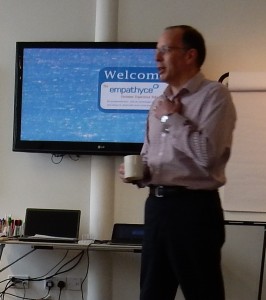Customer Experience – what’s your problem?
What’s your problem with customer experience? Or, to put it another way, what is it that gets in the way of designing and implementing an effective customer experience strategy?
Such customer experience problems were the source of much debate recently when I had the pleasure of hosting the Empathyce TakeAway event in London. There were no presentations, those who attended set the agenda; we simply had rich and highly relevant conversations around the room where everyone could  offer their insights on addressing others’ issues and get feedback on their own.
offer their insights on addressing others’ issues and get feedback on their own.
It was interesting to see further validation that whatever the sector there is a thread of common issues. My co-host for the day was good friend and customer experience specialist Ian Golding – we were joined by people who worked in B2B and B2C (or, more accurately, P2P: People to People) from markets that included aviation, travel, property development, communications, legal services and social media. And yet there was hardly a single issue that was the preserve of only one market.
Top of the list and driving everything else was culture. Especially, the gap between how customer-centric organisations tell their stakeholders and employees they are and what they are in reality. A big part of a customer experience professional’s role is to influence where there isn’t direct authority but in an ideal world that wouldn’t need to be an issue. Having the right culture removes the need to influence others in the organisation who either can’t or don’t want to see beyond their process, metric or product focus. It’s easier said than done, it can be a lone voice to start with but is absolutely critical to any success.
Another hot topic is the conundrum created by the tension between personalisation and digitalisation. As a consumer, we want timely and relevant information but we also don’t want it cross a line into being intrusive, noisy and over-bearing. However, as a business we can be seduced by the promises of efficiency that digitalisation, self service and big data can bring. Technology allows us to make things incredibly personal, but it must be the customer’s definition of personal, not ours.
I also can’t remember a time when breaking through internal silos and aligning everything wasn’t a concern. And yet getting people in the same company to collaborate, to understand each other and to work to the same priorities remains a significant challenge. It’s another sub-set of the culture issues; there’s no point in having a customer experience team working their socks off to champion the cause if in another part of the business teams are motivated and rewarded by the ticking of non-customer boxes.
Talking of which, measurement is always a fascinating subject. Using the right type of measurement, tracking the right thing, understanding what the results are saying and sharing them in a way that brings about the right change are all customer experience fundamentals. Again, despite all the customer-rhetoric, especially in metric and process driven organisations, there always remains the risk, often a reality, of obsessing about the number at the cost of knowing what is making the numbers what they are.
Armed with endless mugs of coffee and delicious food at the fantastic (and thoroughly recommended) Wallacespace, we continued to share experiences and views on how companies address these issues and more; the psychology of queuing and its false economy of processing efficiencies, capturing and doing something about the niggles and gripes rather than just focusing on complaints and the use of social media and gamification to nurture customer engagement.
What is your problem? The issue I’ve touched on here only scratch the surface so I’d love to hear what your most pressing customer experience challenges are or how you’ve seen others overcome.
Wherever possible I’d urge you to talk to others outside your business, outside your market. Chances are, whatever you are dealing with someone, somewhere will have some helpful thoughts. Forgive the plug but we’ve had some great feedback about the Take Away event so if you’re interested in attending one of the next ones there are more details here. Ian Golding is alway worth listening to about what makes good or bad experiences, what to do next and how to make the right changes so have a look at his blog over at ijgolding.com.
Of course talking about it is only the beginning. The real benefits start happening and problems start disappearing only when there is action; the right action.

Leave a Reply
Want to join the discussion?Feel free to contribute!